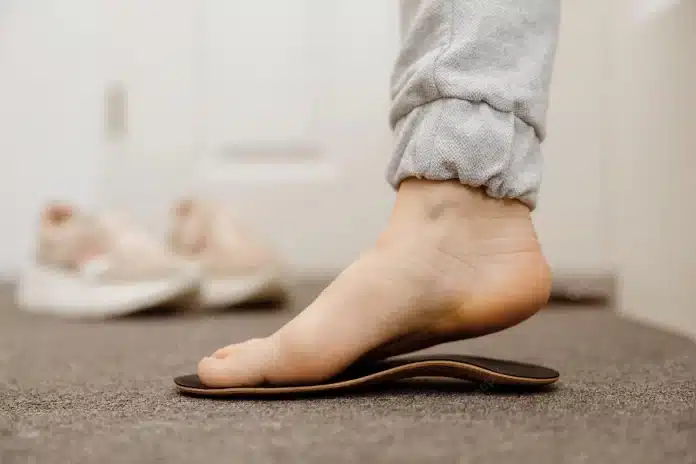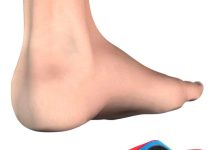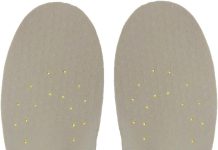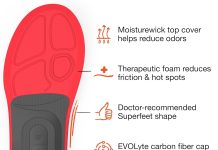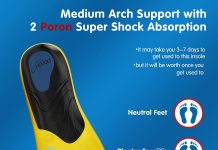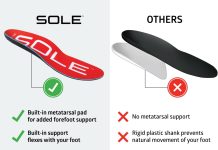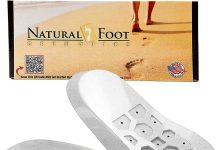Are you suffering from flat feet? Do your shoes no longer feel comfortable? If so, then you might want to consider investing in insoles.
Insoles are a great way to provide extra cushioning and support for those of us with flat feet. This article will discuss the best insoles for flat feet and their benefits.
Do you ever experience foot pain or fatigue when walking? Are your current shoes just not providing enough cushion or support? Unfortunately, many people with flat feet find regular footwear can cause discomfort over time.
That’s why investing in a good pair of insoles is essential if you have flat feet. With proper arch support, shock absorption, and cushioning – insoles can make all the difference!
So which ones should you buy? Let’s look at some of the top-rated insoles specifically designed for those with flat feet.
We’ll cover everything from price points to features, so by the end of this article; you should know exactly what kind of insole is right for your needs. Stay tuned as we discuss how these incredible products can help improve your comfort level while walking and running!
Definition Of Flat Feet
Flat feet, also known as pes planus or fallen arches, are a condition that affects the arch of your foot. It occurs when the tendons on the bottom of your foot weaken and cannot support the weight placed upon them.
Symptoms may include pain in the heel or arch area, difficulty walking for long periods, or swelling around the ankle.
There are two types of flat feet: flexible and rigid. Flexible flat feet occur when you can still see an arch when standing with body weight on both feet, but it flattens out when bearing pressure is applied during activities like running. Rigid flat feet are much less common; this type of flatness does not show any change in shape, even with added pressure from activity.
Diagnosis for flat feet typically includes a physical exam where your doctor will check for signs such as pain, tenderness along parts of your foot, and tendon tightness. Additionally, they may ask you to stand on one leg while they press down gently on different areas of your foot to assess flexibility.
Treatment often involves rest and wearing supportive shoes designed specifically for people with flat feet. Custom orthotics can help provide additional stabilization to alleviate symptoms associated with flat feet.
Causes Of Flat Feet
Flat feet, also known as fallen arches, are conditions where the arch of one’s foot collapses. This often causes pain and discomfort in the feet, ankles, hips, and other body parts.
There are many possible causes for flat feet, including genetics, injury or trauma to the foot, obesity, certain medical conditions such as rheumatoid arthritis or diabetes, and wear and tear due to age.
Genetics plays an important role when it comes to developing flat feet. If someone has parents with flat feet or another type of foot deformity, they may have a higher chance of developing this condition.
Injury or trauma to the foot can cause swelling in the ligaments that hold up the arch, leading to collapsed arches. Obesity is another factor since extra weight puts more pressure on the bones and joints of your feet, causing them to flatten out.
Lastly, some medical conditions like rheumatoid arthritis and diabetes can affect muscles around your foot, leading to flat feet over time due to lack of strength or mobility issues.
Depending on the severity, various treatment options are available, ranging from orthotics (shoe inserts) designed specifically for people with flat feet to surgical procedures that realign tendons and ligaments to restore standard arch height.
In some cases, physical therapy might be recommended along with lifestyle changes such as exercising regularly and maintaining a healthy weight to reduce pain associated with flat feet.
Regardless of what method you choose for treating your flat feet, it’s important to remember that proper care should be taken so that further damage does not occur down the line.
Symptoms Of Flat Feet
Now that we’ve established the causes of flat feet let’s explore the symptoms. Flat feet can cause a variety of problems and discomfort in the feet.
Knowing what signs to look for is essential in diagnosing this condition and seeking treatment.
The most common symptom of flat feet is pain when walking or standing. This pain usually occurs on the inside part of your foot near the arch. Other symptoms include swelling around the ankles, backaches, leg cramps, general fatigue throughout the lower body, and difficulty running or jumping due to an overall lack of stability.
In some cases, people with flat feet may also experience numbness or tingling sensations in their legs or toes.
Flat feet can lead to more severe issues if left untreated over time. These conditions might include plantar fasciitis, Achilles tendonitis, shin splints, bunions, and corns on your toes, and arthritis in your joints and ligaments caused by increased strain on them from having flat feet.
It’s essential to be aware of these potential risks and seek medical attention if you suspect you have flat feet before they become too severe.
No matter how mild or severe your flat-feet-related symptoms are, it’s always recommended to see a doctor for diagnosis and advice about treatments like orthotics insoles which help to cushion arches while adding support where needed. I am walking much more accessible with less pain associated with it.
Types Of Insoles For Flat Feet
The right type of insole is a crucial component in treating flat feet. Standard insoles for flat feet include orthotics, arch-supporting footbeds, and shock-absorbent cushioning.
- Orthotic Insoles: These are designed to support the arches and reduce strain on the ankles, knees, hip joints, and lower back. They also help with pronation or rolling inward of the ankles when walking or running.
- Arch-Support Footbeds: These provide cushioning and support for flat feet. The material inside these footbeds helps maintain an arch shape so that it does not collapse during movement, which can cause pain and discomfort in your feet and legs.
- Shock-Absorbent Cushioning: Shoes with this feature have thick foam layers placed between the sole and upper part of the shoe that absorbs some of the impacts from each step while walking or running resulting in less fatigue in your feet and legs over time.
- Custom-Made Insoles: If you suffer from severely flat feet, custom-made insoles may be necessary for providing better comfort and stability compared to other over-the-counter options available today.
No matter what type of treatment you opt for, finding the correct type of insoles for flat feet can make a difference in helping alleviate pain associated with this condition and improving overall mobility and quality of life.
How To Choose The Right Insole For You
There are a few options when choosing the best insoles for flat feet. The most crucial factor to consider is arch support. This will help to distribute your body weight evenly and reduce pain or discomfort in your feet.
Custom insoles can also be beneficial, providing a customized fit for your foot shape. Shock-absorbing insoles can help with cushioning and stability while walking or running on hard surfaces.
Doctors often recommend orthotic insoles for chronic foot problems such as plantar fasciitis. They offer superior arch support and adjustability so you can get the proper support for your needs.
Additionally, orthotics typically come with features like heel cups and metatarsal pads that can give added comfort and relief from pressure points associated with specific flat feet.
Overall, finding the correct type of insole depends mainly on the symptoms you’re experiencing due to flat feet and how much support you need from an insole.
It’s always advisable to consult a doctor before buying any shoe insert since everyone has unique needs when it comes to their feet’ health – this way, you’ll make sure that you’re getting exactly what’s necessary for optimal comfort and relief from pain and other issues related to flat feet.
Plantar Fasciitis Feet Insoles Arch Supports Orthotics Inserts Relieve Flat Feet, High Arch, Foot Pain Mens 8-8 1/2 | Womens 10-10 1/2
Arch Heavy Support Pain Relief Orthotics - 210+ lbs Flat Foot Heel Pads Plantar Fasciitis Work Boots Insole Inserts for Men and Women(Size:US-10,length-29cm,Red)
Plantar Fasciitis Pain Relief Feet Insoles Orthotics Arch Support Insoles with Motion Control Shoe Inserts Work Boot Flat Feet for Men and Women Improve Balance, XS
Advantages Of Wearing Insoles For Flat Feet
Wearing insoles for flat feet can provide advantages to those who suffer from this condition. Insoles come in different types, each offering various benefits depending on the person’s needs. This includes arch support, cushioning, and custom or orthotic insoles.
To ensure that a person gets the most out of their flat feet insoles, it is essential to understand what type of insole would be best suited for them. The following table outlines some of the main differences between these three types:
Arch support insoles are designed with a gentle curve that fits around the contours of your feet, providing stability and relieving pressure points. Over time they will mold and conform to your unique foot shape while offering comfort and support.
A cushioning insole is ideal if you experience discomfort due to excess impact when walking or running, as these reduce friction and absorb shock by adding extra cushioning underfoot.
Custom or orthotic insoles take things one step further by being specifically designed according to your unique foot shape and correcting any biomechanical issues you may have – making them an effective long-term solution for pain caused by flat feet.
With so many options available, there is sure to be an insole perfect for anyone suffering from flat feet. Individuals must consult a podiatrist before purchasing an insole to decide which type is best for them.
Tips On Taking Care Of Your Insoles
Properly caring for your insoles can help maximize their benefits, allowing them to provide the best possible support and cushioning. It is essential to know how to store and clean your insoles and when it’s time to replace them.
Please keep your insoles in a cool, dry place when you’re not wearing them. Don’t leave them exposed on surfaces like countertops or carpets that could become wet or dirty – this will reduce the material’s lifespan over time. It would be best to avoid direct sunlight, which can cause fading and discoloration.
Regular cleaning is necessary to maintain hygiene and extend the life expectancy of your insoles. Remove the inserts from your shoes and wash them with warm water and mild detergent before leaving them to air-dry completely.
Additionally, regularly inspect each insert for signs of wear pattern analysis; if any visible creases or tears start forming, it may be time to invest in a new pair of insoles.
By following these simple tips on taking care of your insoles, they’ll continue providing optimal sole cushioning while helping relieve flat feet discomfort.
Long-Term Effects Of Wearing Insoles For Flat Feet
The long-term effects of wearing insoles for flat feet are highly beneficial. Insoles provide supportive cushioning and arch support, which can help to alleviate any pain or discomfort caused by flat feet over time.
This support helps keep the foot appropriately aligned and prevents further damage from occurring. Additionally, having a cushioned insole supports the heel and arch area and relieves pressure on other areas of the foot, such as the toes.
Another benefit of using an insole is that it reduces fatigue associated with standing or walking for prolonged periods. The additional cushioning provided by the insole helps reduce stress on your feet, allowing you to remain comfortable throughout the day without feeling tired or sore afterward.
Furthermore, wearing an insole can improve posture, providing better balance and stability when standing or walking.
Finally, wearing insoles for flat feet can improve mobility and range of motion due to increased comfort while walking or running. With proper arch support, people with flat feet can move more freely without experiencing pain or discomfort.
In addition, adequate cushioning protects against potential injury during physical activity due to its shock absorption capabilities.
As a result, individuals who wear insoles can enjoy an improved performance during exercise and daily activities due to enhanced protection and comfort provided by their footwear choice.
Plantar Fasciitis Feet Insoles Arch Supports Orthotics Inserts Relieve Flat Feet, High Arch, Foot Pain Mens 8-8 1/2 | Womens 10-10 1/2
Arch Heavy Support Pain Relief Orthotics - 210+ lbs Flat Foot Heel Pads Plantar Fasciitis Work Boots Insole Inserts for Men and Women(Size:US-10,length-29cm,Red)
Plantar Fasciitis Pain Relief Feet Insoles Orthotics Arch Support Insoles with Motion Control Shoe Inserts Work Boot Flat Feet for Men and Women Improve Balance, XS
Frequently Asked Questions
How Long Do Insoles For Flat Feet Last?
When it comes to flat feet insoles, one of the most critical questions is, “How long do they last?” It’s a valid inquiry that needs to be addressed when considering treatment options and evaluating costs.
The lifespan of an insole will vary depending on how often you wear them, as well as other lifestyle factors such as your weight and activity level.
In general, flat-foot insoles are designed to provide support over time. This means that if you use them regularly and take good care of them, they should last up to several months before needing replacement.
However, there may also be some people who find their insoles need replacing more frequently due to increased wear-and-tear or heavier body weight causing extra strain on the soles. Therefore, monitoring usage is essential so you can replace them accordingly.
Fortunately, flat-foot insoles don’t usually come with a hefty price tag—so stocking up on multiple pairs isn’t too expensive either!
Combined with regular exercise and proper footwear selection, these treatments can drastically improve the quality of life for those suffering from flat feet. Ensuring you have enough replacements handy helps ensure that this lifestyle management continues uninterruptedly.
However, understanding the lifespan of available solutions is critical for anyone looking into treating their flat feet condition to decide which route best suits their needs and budget constraints.
Is There A Difference Between Insoles For Flat Feet And Regular Insoles?
When it comes to insoles, there is often a question of whether or not there is a difference between those designed specifically for flat feet and regular insoles. Flat feet are a common condition that can cause pain, fatigue, and difficulty walking if left untreated.
It’s essential to understand the differences between these two insoles to choose the right one for your needs.
Flat feet insoles are specially designed with contours and support features that provide maximum comfort and stability for people with flat feet. They help reduce strain on the arches, absorb shock, and promote proper foot alignment.
Regular insoles may offer some arch support, but they typically don’t have as much cushioning or other specialized features as those for flat feet.
The type of insole you choose depends on the severity of your flat feet condition and the type of foot treatment you seek. For milder cases, regular insoles might relieve discomfort or fatigue caused by misalignment.
However, more severe cases will likely require something more substantial such as custom-made orthotics or special shoes designed specifically for people with flat feet. Ultimately, it’s best to consult your doctor before deciding which type of insole would work best for you since everyone’s needs differ when treating their flat feet.
No matter what type of insole you choose –regular or flat feet– taking care of them properly is critical to getting the most out of them over time.
Make sure to clean them regularly and replace them after a few months so they can continue providing optimal support and comfort while keeping your feet healthy!
Are There Any Lifestyle Changes That Can Help Improve Flat Feet?
When it comes to flat feet, the lifestyle choices someone makes can significantly impact their condition.
It’s important to understand that insoles may help improve foot health and comfort, but one can also make other lifestyle changes to improve flat feet. Flat feet exercises, treatments, and other lifestyle changes can be beneficial in alleviating pain and improving overall foot health.
Understanding what types of treatments or exercises might be recommended for flat feet is essential to managing this condition. For example, specific stretching exercises like calf stretching and ankle rolling can help strengthen muscles and tendons around the foot, which can help reduce discomfort from flat feet.
Additionally, wearing supportive shoes with arch support inserts may help relieve the pressure associated with flat feet. Other lifestyle changes, such as avoiding high-impact activities or taking regular breaks throughout the day, could also improve foot health in individuals with flat feet.
Overall, making minor adjustments to daily habits and routines can go a long way toward helping manage symptoms related to flat feet.
Taking time each day for simple foot stretches or treating oneself to comfortable new shoes with arch support could reduce pain and keep one’s feet healthy.
While finding suitable treatment options will vary depending on each individual’s needs, these lifestyle modifications should not be overlooked when considering how best to alleviate issues caused by flat feet.
Are There Any Treatments Available For Flat Feet?
When it comes to flat feet, many people are looking for treatments that can provide relief and a cure. Flat feet treatment is an essential consideration for individuals living with this condition.
There are several therapies available that can help those suffering from flat feet find the relief they need.
Flat feet therapy typically involves exercises designed to stretch and strengthen the muscles in the foot’s arch. This exercise helps reduce strain on the joints caused by flat feet, helping improve overall comfort levels.
Specific stretches may also be prescribed as part of a personalized plan to address flat feet issues. In addition, orthotics or special insoles may be recommended to provide additional support and cushioning for the arches of the feet.
Other treatments for flat feet include physical therapy and custom-made shoe inserts called orthotics, which help redistribute weight throughout your step cycle and relieve pressure points associated with flat feet.
Additionally, various home remedies such as ice packs and rest periods can help alleviate pain associated with flat feet. Lastly, anti-inflammatory drugs can reduce swelling and discomfort related to this condition so you can quickly return to your daily routine.
No matter what kind of treatment you choose, it’s important to remember that there is no one size fits all solution to managing symptoms of flat feet.
It’s essential to work closely with a medical professional who understands your needs and will create a customized plan based on your lifestyle goals and health history to maximize symptom relief while ensuring long-term comfort levels are maintained over time.
Plantar Fasciitis Feet Insoles Arch Supports Orthotics Inserts Relieve Flat Feet, High Arch, Foot Pain Mens 8-8 1/2 | Womens 10-10 1/2
Arch Heavy Support Pain Relief Orthotics - 210+ lbs Flat Foot Heel Pads Plantar Fasciitis Work Boots Insole Inserts for Men and Women(Size:US-10,length-29cm,Red)
Plantar Fasciitis Pain Relief Feet Insoles Orthotics Arch Support Insoles with Motion Control Shoe Inserts Work Boot Flat Feet for Men and Women Improve Balance, XS
Are Insoles For Flat Feet Expensive?
Are insoles for flat feet expensive? This is a common question among those with flat feet, as the cost of treatment can be an essential factor in deciding which type of solution to pursue. Fortunately, options are available at various price points that suit your budget.
Insoles specifically designed for people with flat feet come at different prices. Many brands offer lower-cost over-the-counter orthotics that are effective and provide good support.
Higher-end models cost more but often include additional features like custom molding or shock absorption. Finding something within your budget is possible depending on the severity of your condition and what you need from your insoles.
If you’re looking for extra cushioning or arch support, you may want to consider investing in more expensive insoles. Ultimately, how much you’ll spend depends on the materials used and any bells and whistles included with the product – but whatever option you choose should ensure your feet get the proper care they need.
Whether looking for a basic model or one packed with features, there are plenty of choices for finding insoles suitable for flat feet that won’t break the bank.
Researching different products will help ensure you select the right pair for your individual needs at the right price point.
Conclusion
In conclusion, flat feet can pose a challenge when finding the right insoles.
Several factors go into selecting the best insoles for flat feet, such as how long they last and whether there is any difference between regular and specialized insoles.
While lifestyle changes and treatments can also help improve flat feet, adding the correct insole could be a great way to start feeling better.
The good news is that these specialized insoles don’t have to break the bank – you can find quality ones at reasonable prices. So if you suffer from flat feet, try investing in some comfortable insoles today!
Plantar Fasciitis Feet Insoles Arch Supports Orthotics Inserts Relieve Flat Feet, High Arch, Foot Pain Mens 8-8 1/2 | Womens 10-10 1/2
Dr. Scholl's ® Heavy Duty Support Insoles, Men, 1 Pair, Trim to Fit
$12.68 in stock

